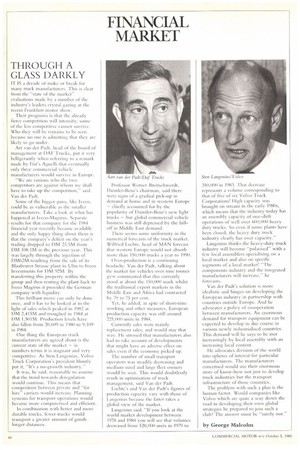THROUGH A GLASS DARKLY
Page 46

If you've noticed an error in this article please click here to report it so we can fix it.
IT IS a decade of make or break for many truck manufacturers. This is clear from the "state of the market" evaluations made by a number of the industry's leaders crystal gazing at the recent Frankfurt motor show.
Their prognosis is that the already fierce cornpetition will intensify; some of the less competitive cannot survive. Who they will be remains to be seen because no one is admitting that they are likely to go under.
Art van der Padt. head of the board of management at DM' Trucks, put it very belligerantly when referring to a remark made by Fiat's Agnelli that eventually only three coot nercial vehicle manufacturers would survive in Europe.
"We are curious who the two competitors are against whom we shall have to take up the competition," said Van der Padt.
Some of the bigger guns, like keen. could be as vulnerable as the smaller manufacturers. Take a look at what has happened at Iveco-Magirus. Separate • results for that company for the 1984 financial year recently became available and the only happy thing about them is that the company's deficit on the year's trading dropped to DM 23.5M from DM 108.1M in the previous year. This was largely through the injection of DM62M resulting from the sale of its Blaubeurer Strasse plant in Ulm to Iveco Investments for DM 92M. By transferring this property within the group and then renting the plant back to Iveco Magirus it provided the German company with liquidity.
This brilliant move can only be done once, and it has to be looked at in the light of sales winch peaked in 1982 at DM 2,41 3M and troughed in 1984 at DM 1,501M. Production levels have also fallen from 20,N19 in 1980 to 9,109 in 1984.
One thing the European truck manufacturers are agreed about is the current state of the market — in numbers terms it is stagnant and very competitive. As Sten Langenius, Volvo Truck Corporation's president bluntly put it, "It's a no-growth industry."
It was, he said, reasonable to assume that the trend towards deregulation would continue. This 1111%111ti that competition between private and "for hire" carriers would increase. Planning systems for transport operations would became more computerised and efficient.
In combin;ition with better and more durable trucks, fewer trucks would transport a greater amount of goods longer distances.
Professor Werner Breitschwerdt, Daimler-Benz's chairman, said there were signs of a gradual pick-up in demand at home and in western Europe — chiefly accounted for by the popularity of Dainder-Benz's new light trucks — but global commercial vehicle business was still depressed by the fulloff in Middle East demand.
There scents some uniformity in the numerical forecasts of the truck market. Wilfried Lochte, head of MAN forecast that western Europe would not absorb more than 150,000 trucks a year Co 1990.
Over-production is a continuing headache. Van der Paclt, talking about the market for vehicles over nine tonnes gvw commented that this currently stood at about the 150,000 mark whilst the traditional export markets in the Middle East and Africa had contracted by 70 to 75 per cent.
Yet, he added, in spite of short-time working and other measures, European production capacity was still around 225,0(K) units in 1984.
Currently sales were mainly replacement sales, and would stay that way. F le stressed that manufacturers also had to take acc-ount 0 developnients that might have an adverse effect on sales even if the economy picked up.
The number of small transport operators was steadily decreasing and medium sized and large fleet owners would be seen. This would doubtlessly result in optimisation of truck management, said Van der Pack.
Lochte's and Van der Padt's figures of production capacity vary with those of Langenius because the latter takes a global view of die market.
Langenius said: "If you look at the world market development between 1978 and 1984 you will see that volumes decreased from 520,000 units in 1979 to
350,(88) in 1983. That decrease represents a volume corresponding to that of five of six Volvo Truck Corporations! I ugh capacity w-as brought on stream in the early 1980s, which means that the industry today has an assembly capacity of one-shift operations of well over 600,000 heavy duty trucks. So even if some plants have been closed, the heavy duty truck industry clearly has over capacity."
Langenius thinks the heavy-duty truck industry will become "polarised" with a few local assemblers specialising on a local market and also on specific segments of a local market! "The components industry and the integrated manufacturers will increase," he forecasts.
Van der Padt's solution is more idealistic and hinges on developing the European industry in partnership with countries outside Europe. And he advocates a policy of co-operation between manufacturers. An enormous demand for transport equipment can be expected to develop in due course in various newly industrialised countries. This demand will he says to be met increasingly by local assembly with an increasing local content.
He advocates division of the world into spheres of interest for particular manufacturers. The manufacturers concerned would use their enormous store of know-how not just to develop truck industries but the transport infrastructure of' those countries.
The problem with such a plan is the human factor. Would companies like Volvo which are quite a way down the road in developing their own global strategies be prepared to join such a club? The answer must be "surely not."
by George Malcolm












































































































